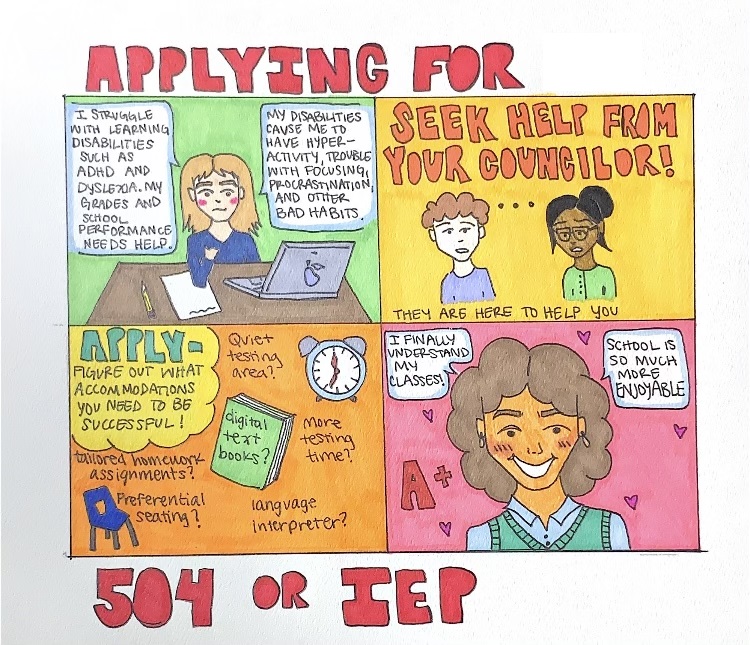
In the wake of the American civil rights movement, disability rights activism began gaining traction as advocates saw the opportunity to address the equitable treatment of disabled Americans alongside other minority groups.
In response to growing pressure, local and federal government officials would pass a series of bills over the next several decades aiming to expand the rights and treatment of disabled Americans, with language influenced by other civil rights bills of the 1960s and ‘70s.
The Rehabilitation Act of 1973 (Rehab Act), which contains Section 504, was the first legislation of its kind to extend equal access and protection to disabled Americans. The act, as Amended, prohibits discrimination on the basis of disability by federal agencies, initatives, and programs receiving federal financial aid.
According to the National Association of the Deaf, “The Rehabilitation Act of 1973 … approves grants to states for vocational rehabilitation services, supported employment, independent living, and client assistance.” Additionally, the legislation “includes a set of rules focused on rights, advocacy, and protections for people with disabilities.” This act would set the precedent for similar legislation across the country.
The Americans with Disabilities Act for 1990 (ADA) , further reinforcing the policies enacted by the 1973 Rehab Act. The ADA is a civil rights law that further prohibits “discrimination against individuals with disabilities in all areas of public life, including jobs, schools, transportation, and all public and private places that are open to the general public.”
The ADA was further amended in 2008, with the purpose of widening the scope of people protected by the act. Since 2009, more and more Americans can qualify for disability protections.
What are IEPS?
In order to make these rights accessible in the classroom, 504 Plans, Individualized Educational Plans (IEP), and other accommodations offer formal and personalized support for students with physical, cognitive, and sensory disabilities.
Nationally, 2.3% of public school students have 504 Plans, and 14% of students have an IEP.
IEPs, or Individualized Education Programs, first introduced by the Individuals with Disabilities Education Act (IDEA) in 1975, are education plans designed to allow elementary and secondary school students to receive specialized instruction and services beyond the general education classroom.
A student may obtain an IEP through an evaluation process. Roosevelt school psychologist John Lynch says “A student is referred for an evaluation and the concerns would drive what testing is being done. The state has a list of 14 different disability [categories] that a student could possibly qualify for special education.” These disabilities can include autism, and other developmental delays, as well as brain injuries or impairments.
After a student has received a plan, they are re-evaluated once a year, or at parental request. If necessary, changes will be made to the student’s plan. This is but one way of guaranteeing a student a free appropriate public education.
What are 504s?
504 Plans were introduced under Section 504 of the Rehab Act. Section 504 is a law designed to eliminate discrimination based on disability in all federally funded institutions.The Seattle Public Schools (SPS) Student Section 504 Handbook outlines that “Since all public school districts receive Federal funds, all public school districts must comply with Section 504,” including Roosevelt High School. In other words, every student in public school has the legal right to free appropriate public education (FAPE).
It is important to note, however, that these protections do not extend to independently funded private schools.
504 Plans can work in tandem with or without an IEP, covering disabilities exempt from the IDEA. Disabilities most commonly include vision or hearing impairments, as well as mental impairments such as ADHD and anxiety, and must substantially limit a major life activity.
Accommodations such as large-print testing sheets and teachers equipped with microphones may aid students with physical disorders, whereas increased allotted testing time aids students with mental disorders.
Differences Between 504s and IEPs
IEPs and 504s differ in their limitations, with IEPs common among students who need to take special classes and cannot fully remain on the general education track. They may take any combination of general and special education classes, and must take as many general education classes as they are capable of. Both types of plans have the same goal of providing students with the support needed to reach their full potential.
Another difference is in accommodations vs. modifications. According to the Arizona Center for Disability Law, “Accommodations allow a student to learn the same material, but in a different way. Modifications change what a student is taught or expected to learn.” While both plans allow for student accommodations, modifications of the curriculum can only be required under an IEP. No matter how they take a test, 504 students still take the same test as non-504 students. That may not be true for IEP students.
There are many different disabilities that could lead to a student being evaluated. “When a student is referred for an evaluation, I go through testing, I get input from teachers, from parents, from the students, and look to see if the student meets the eligibility criteria for special education services under a specific eligibility category,” Lynch says. Once the process is complete, the IEP can be implemented.
504 Plans allow the playing field to be leveled so that students can demonstrate their true potential. Shannon Lewis, SPS Student Supports 504 and ADA Coordinator, elaborates, “There’s no guarantee that students can get a specific grade just because they have a 504 Plan. 504 Plans all have the same graduation requirements. So, we’re not allowed to change the learning targets.” This means that grading standards and grades are not modified pursuant to 504 Plans.
Qualification for 504 Accommodations
In order to receive 504 accommodations, students must meet certain eligibility requirements in which parents, students, and school staff members are involved in the placement. “We go through an evaluation process and then we ask three questions,” says Shanon Lewis, SPS Student 504/ADA Coordinator. “First question is, does a student have a disability or a medical condition? And they either say yes or no. So saying no stops the process, saying yes moves to question number two.”
Roosevelt High School counselor Ron Stuart explains that in order to qualify, a student’s disability must also interfere with their education in a general education classroom, “The second is it has to be shown that [the] disability is having a significant impact on their learning.”
Even with the first two questions answered yes, that only qualifies a student for Civil Rights protections. Civil Rights protections are different from a 504 Plan, which is a specific plan identified to help a student.
While the first two questions qualify a student for Civil Rights protection, the last question determines the specific plan to address a student’s individual needs. “Does the disability manifest itself so that the student is unable to access their free and appropriate public education [FAPE]?” says Lewis. “You answer yes to that, then the student would then receive an accommodation plan.”
Academic Achievement
Many students who have disabilities struggle to the point of dropping out, but with the addition of IEPs, students are able to achieve much more. Lynch says, “The majority of students that started ninth grade and qualify for special education with the help of their teachers reach graduation.” In the Class of 2018, 81% of American students receiving special education graduated high school. However, Washington lagged noticeably behind, with a graduation rate of 62%.
Since the federal government began implementing the law in 1973, all schools receiving federal funding have been required to implement 504 and IEP Plans, so all districts are following the basic rules. However, there are some differences.
Underdiagnosis
Not all schools implement 504s and IEPs at the same rate. There are 12,229 public schools, and 327 districts in America that don’t have a single 504 Plan. This equates to one in eight schools, leaving thousands of students without plans they would greatly benefit from.
After working in different districts, Stuart says, “I think in those other districts where I worked, we were held a little bit more firm to [make] sure a student was being significantly impacted by their disability to then allow [for a 504] Plan.” After coming to Roosevelt, he says, “When I first came here, it was more like this person has a disability, well, we better write up a plan for them.”
There are always improvements to be made surrounding special education, but the benefits seen by 504 and IEP are immense. And the main goal is to see everyone do their best, regardless of what plan is behind them.



